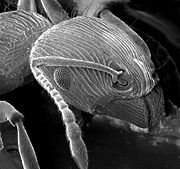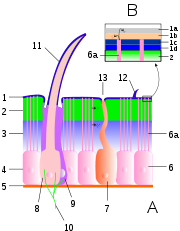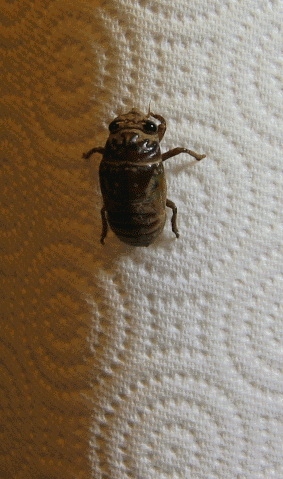
Arthropod exoskeleton
Encyclopedia

Exoskeleton
An exoskeleton is the external skeleton that supports and protects an animal's body, in contrast to the internal skeleton of, for example, a human. In popular usage, some of the larger kinds of exoskeletons are known as "shells". Examples of exoskeleton animals include insects such as grasshoppers...
, which may be mineralised or constructed of a tough polymer such as chitin
Chitin
Chitin n is a long-chain polymer of a N-acetylglucosamine, a derivative of glucose, and is found in many places throughout the natural world...
. This external skeleton is moulted as the organism grows.
Microscopic structure

Squamous epithelium
In anatomy, squamous epithelium is an epithelium characterised by its most superficial layer consisting of flat, scale-like cells called squamous epithelial cells...
and basement membrane
Basement membrane
The basement membrane is a thin sheet of fibers that underlies the epithelium, which lines the cavities and surfaces of organs including skin, or the endothelium, which lines the interior surface of blood vessels.- Composition :...
. Of these, the epicuticle is a multi-layered external barrier that, especially in terrestrial arthropods, acts as a barrier against desiccation
Desiccation
Desiccation is the state of extreme dryness, or the process of extreme drying. A desiccant is a hygroscopic substance that induces or sustains such a state in its local vicinity in a moderately sealed container.-Science:...
. The strength of the exoskeleton is provided by the underlying procuticle, which is in turn secreted by the epidermis. Arthropod cuticle is a biological composite material
Composite material
Composite materials, often shortened to composites or called composition materials, are engineered or naturally occurring materials made from two or more constituent materials with significantly different physical or chemical properties which remain separate and distinct at the macroscopic or...
, consisting of two main portions: fibrous chains of alpha-chitin
Chitin
Chitin n is a long-chain polymer of a N-acetylglucosamine, a derivative of glucose, and is found in many places throughout the natural world...
within a matrix of silk-like and globular proteins, of which the most well-known is the rubbery protein called resilin
Resilin
Resilin is an elastomeric protein found in many insects. The protein was first discovered by Torkel Weis-Fogh in the locust wing-hinge. As of 2005 it is the most efficient elastic protein known . The elastic efficiency of the resilin isolated from locust tendon has been reported to be 97 %...
. The relative abundance of these two main components varies from approximately 50/50 to 80/20 chitin protein, with softer parts of the exoskeleton having a higher proportion of chitin. Although the cuticle is relatively soft when first secreted, it soon hardens in a poorly-understood process that involves dehydration
Dehydration
In physiology and medicine, dehydration is defined as the excessive loss of body fluid. It is literally the removal of water from an object; however, in physiological terms, it entails a deficiency of fluid within an organism...
and/or tanning
Tanning
Tanning is the making of leather from the skins of animals which does not easily decompose. Traditionally, tanning used tannin, an acidic chemical compound from which the tanning process draws its name . Coloring may occur during tanning...
mediated by hydrophobic chemicals called phenolics
Phenols
In organic chemistry, phenols, sometimes called phenolics, are a class of chemical compounds consisting of a hydroxyl group bonded directly to an aromatic hydrocarbon group...
. Different types of interaction between the proteins and chitin leads to varying mechanical properties of the exoskeleton.
In addition to the chitino-proteinaceous composite of the cuticle, many crustaceans, some myriapods and the extinct trilobites further impregnate the cuticle with mineral salts, above all calcium carbonate, which can make up up to 40% of the cuticle. This can lead to great mechanical strength.
Mechanical properties
The two layers of the cuticle have different properties.The outer, sclerosed layer is very strong under compressive forces, but much weaker under tension. When it fails, it does so by cracking. The inner layer is not sclerosed, and is thus much softer; it is able to resist tensile forces but is liable to failure under compression.
This combination is especially effective in resisting predation, as predators tend to exert compression on the outer layer, and tension on the inner.
The degree of scleritisation affects how the cuticle responds to deformation. Below a certain point - and this point will be higher the more scleritised the cuticle is - deformation is elastic and the original shape is returned to after the stress is removed. Above this point, plastic (non-reversible) deformation occurs until finally the cuticle cracks.
Segmentation
The arthropod exoskeleton is typically divided into different functional units to allow flexibility in an often otherwise rigid structure. For example, the head is a fused capsule; and the trunk is often divided into a series of articulating sclerites called tergitesTergum
A tergum is the dorsal portion of an arthropod segment other than the head. The anterior edge is called the base and posterior edge is called the apex or margin. A given tergum may be divided into hardened plates or sclerites commonly referred to as tergites...
. In addition, the characteristic limbs of arthropods need to be jointed. The internal surface of the exoskeleton is often elaborated into a set of specialised structures called apodemes that allow the attachment of muscles. Such endoskeletal components of the arthropod skeleton can be highly complex, as in crabs and lobsters.
Ecdysis

- See also main article: EcdysisEcdysisEcdysis is the moulting of the cuticula in many invertebrates. This process of moulting is the defining feature of the clade Ecdysozoa, comprising the arthropods, nematodes, velvet worms, horsehair worms, rotifers, tardigrades and Cephalorhyncha...
The relative rigidity of the exoskeleton means that continuous growth of arthropods is not possible. Therefore, growth is periodic and concentrated into a period of time when the exoskeleton is shed, called moulting or ecdysis
Ecdysis
Ecdysis is the moulting of the cuticula in many invertebrates. This process of moulting is the defining feature of the clade Ecdysozoa, comprising the arthropods, nematodes, velvet worms, horsehair worms, rotifers, tardigrades and Cephalorhyncha...
, which is under the control of a hormone called ecdysone
Ecdysone
Ecdysone is a steroidal prohormone of the major insect molting hormone 20-hydroxyecdysone, which is secreted from the prothoracic glands. Insect molting hormones are generally called ecdysteroids. Ecdysteroids act as moulting hormones of arthropods but also occur in other related phyla where they...
. Moulting is a complex process that is invariably dangerous for the arthropod involved. Before the old exoskeleton is shed, the cuticle separates from the epidermis through a process called apolysis. New cuticle is excreted by the underlying epidermis, and mineral salts are usually withdrawn from the old cuticle for re-use. After the old cuticle is shed, the arthropod typically pumps up its body (for example, by air or water intake) to allow the new cuticle to expand to a larger size: the process of hardening by dehydration of the cuticle then takes place. Newly molted arthropods typically appear pale or white, and darken as the cuticle hardens.

